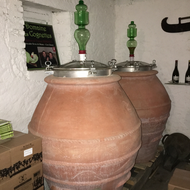Amphora-Aged Wines
Posted by The Oak Barrel on 28th Apr 2022
An amphora is a jar with two vertical handles used in antiquity for the storage and transportation of foodstuffs. They are often clay, and likely evolved from the large Bronze Age pithoi vessels used by the Minoans and Mycenaeans. However, the use of these vessels dates back further than this. The earliest biomolecular archaeological evidence for viniculture in these vessels has been recorded in the Southern Caucasus region (Georgia and Armenia) as far back as the early Neolithic Period, approximately 6,000 BC. Widely used throughout this region today, these large, earthenware jars are called qvevri.
This ancient winemaking method has recently found a renaissance across the world – for good reason. Clay amphorae encourage many desirable processes that build finesse and complexity into wine:
- The finer porosity of clay provides more consistent microoxygenation that is often achieved in wooden barrels. This has the effect of softening the tannins of the wine, lending a more supple mouthfeel
- Thermal stability, especially if buried in the ground, prolongs the development of delicate and complex aromas and flavours
- The shape of the amphora often negates the requirement to fine and filter with additional compounds
- Clay amphorae are also easier to clean, thereby reducing chances of bacterial spoilage
Amphora-aged wines often have a distinctive texture and character. They tend to have larger aromatic profile and are more textural on the palate. The wine usually shows softer fruit, with more earthy, mineral, and nutty characters developing. There is often a perception of depth, as the acidity tends to reduce more quickly when aged in an amphora. In general, amphora-aged wines should have a bright, open, even vibrant quality up front, with a long and rich finish.

